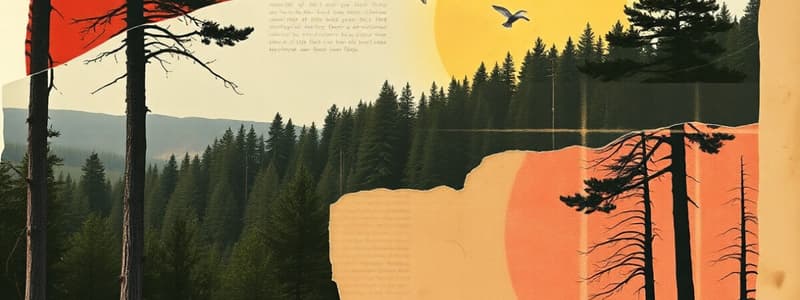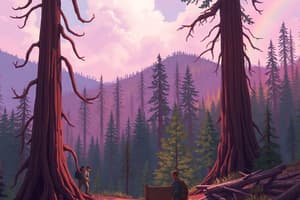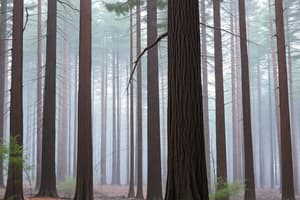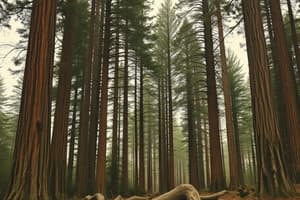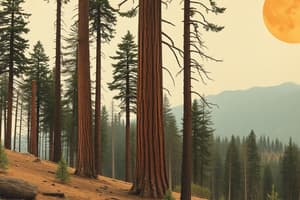Podcast
Questions and Answers
Considering the ecological role of fire in Big Basin, what is the most likely long-term consequence of a century of fire suppression?
Considering the ecological role of fire in Big Basin, what is the most likely long-term consequence of a century of fire suppression?
- A reduction in the frequency of small, controlled burns, leading to healthier forest undergrowth.
- A stabilization of forest ecosystems, resulting in a more predictable and manageable environment.
- A decrease in the overall biodiversity of the park due to the unchecked growth of dominant species. (correct)
- An increase in the population of species that depend on open, recently burned areas for survival.
Which factor most significantly contributed to the extreme fire behavior observed during the August 2020 fire in Big Basin?
Which factor most significantly contributed to the extreme fire behavior observed during the August 2020 fire in Big Basin?
- The convergence of multiple conditions, including accumulated fuel, conducive topography, and adverse weather patterns. (correct)
- The absence of firebreaks and other fuel management strategies within the park's boundaries.
- The singular ignition point which allowed the fire to intensify before spreading.
- The lack of adequate water resources and firefighting equipment to combat the initial outbreak.
How did native populations' historical use of fire differ from the fire dynamics observed in Big Basin over the past century, and what implications did this difference have for the ecosystem?
How did native populations' historical use of fire differ from the fire dynamics observed in Big Basin over the past century, and what implications did this difference have for the ecosystem?
- Native populations avoided using fire altogether, leading to denser forests, whereas modern fires are ignited accidentally, causing widespread destruction.
- Native populations employed frequent, low-intensity burns to promote biodiversity, whereas recent fire suppression led to fuel buildup and catastrophic wildfires. (correct)
- Native populations utilized high-intensity burns for agricultural purposes, whereas modern fires are typically of lower intensity due to fire suppression efforts.
- Native populations used fire randomly to clear land, whereas modern fires are strategically managed for ecological purposes.
Considering the long-term ecological health of Big Basin, what is the intended primary goal of the 'Reimagining Big Basin' project regarding wildfire management?
Considering the long-term ecological health of Big Basin, what is the intended primary goal of the 'Reimagining Big Basin' project regarding wildfire management?
What combination of climatic factors significantly contributes to the increased risk of wildfires in Big Basin?
What combination of climatic factors significantly contributes to the increased risk of wildfires in Big Basin?
If a section of Big Basin has an overabundance of ground vegetation, which of the following actions would best promote ecological health and reduce the risk of a large-scale wildfire?
If a section of Big Basin has an overabundance of ground vegetation, which of the following actions would best promote ecological health and reduce the risk of a large-scale wildfire?
How might the increased sunlight penetration after the August 2020 fire influence forest regeneration and species composition in Big Basin?
How might the increased sunlight penetration after the August 2020 fire influence forest regeneration and species composition in Big Basin?
What does the destruction of park infrastructure during the August 2020 fire highlight about the future of park management in similar environments?
What does the destruction of park infrastructure during the August 2020 fire highlight about the future of park management in similar environments?
Flashcards
Big Basin
Big Basin
California's oldest state park, established in 1902, known for its old-growth redwoods.
Prescribed Fire
Prescribed Fire
The use of controlled burns to reduce fuel buildup and promote ecosystem health.
Fuel Buildup
Fuel Buildup
The accumulation of dead plant material that can fuel wildfires.
Fire Triangle
Fire Triangle
Signup and view all the flashcards
Lightning Siege of 2020
Lightning Siege of 2020
Signup and view all the flashcards
Extreme Fire Behavior
Extreme Fire Behavior
Signup and view all the flashcards
Reimagining Big Basin
Reimagining Big Basin
Signup and view all the flashcards
Ecosystem Resilience
Ecosystem Resilience
Signup and view all the flashcards
Study Notes
Introduction to Big Basin
- Entering Big Basin feels like going back in time.
- Towering trees create a cool, dark, lush setting.
- Some of the last old-growth redwoods are in Big Basin.
- The park is situated in the Santa Cruz Mountains.
- California's oldest state park, founded in 1902.
- It kickstarted the redwood preservation movement.
- Big Basin covers 18,000 acres.
The Role of Fire in the Ecosystem
- Fire is crucial for the health and productivity of Big Basin's ecosystem.
- It promotes biological diversity.
- Fire creates redwood cavities used by bats, squirrels, and raccoons.
- Native Americans used fire for millennia to maintain healthy environments.
- Fire suppression over the past 100-200 years caused fuel buildup.
- This buildup is contributing to massive wildfires.
Factors Influencing Wildfires
- Climate change and warmer temperatures are factors in wildfires.
- Cool, wet winters encourage plant growth, while warm, dry summers hinder decomposition.
- Increased aridity from climate change lengthens the period when fuels are available to burn.
- Fire requires oxygen, fuel (plants), and an ignition source.
The Lightning Siege of 2020
- Record heat preceded a lightning siege in the summer of 2020.
- Thousands of lightning bolts struck the Santa Cruz Mountains.
- The lightning sparked several fires.
The August 2020 Fire
- Initially, the fire appeared beneficial by reducing fuels.
- On August 18th, a wind shift pushed smoke into Big Basin.
- The alignment of fuel, topography, and weather led to extreme fire behavior.
- Three fires merged, causing multiple spot fires throughout the park.
Evacuation and Devastation
- Park staff evacuated Big Basin in approximately three hours.
- The priority became saving staff homes.
- Staff residences were approached by a 100-foot wall of flame.
- 97% of Big Basin, nearly all 18,000 acres burned in under 24 hours.
- 100 structures, 85 miles of trails, 20 staff homes, and a nature museum were destroyed.
The Aftermath and Reimagining
- Soon after the fire, nature began to recover itself.
- Trees are sprouting, and the forest floor is regreening.
- More sunlight allows more plants to grow.
- Wildlife is prospering.
- The Reimagining Big Basin project was created by California State Parks.
- Aiming to rebuild the park to withstand wildfires.
- Plans are to broaden the use of prescribed fire and conserving old growth.
- Also focuses on technology and equitable access to the park.
Recovery and Future Outlook
- Redwood roots connect with surrounding trees, aiding their tall growth.
- The fire will form a new chapter in Big Basin's history.
Studying That Suits You
Use AI to generate personalized quizzes and flashcards to suit your learning preferences.
